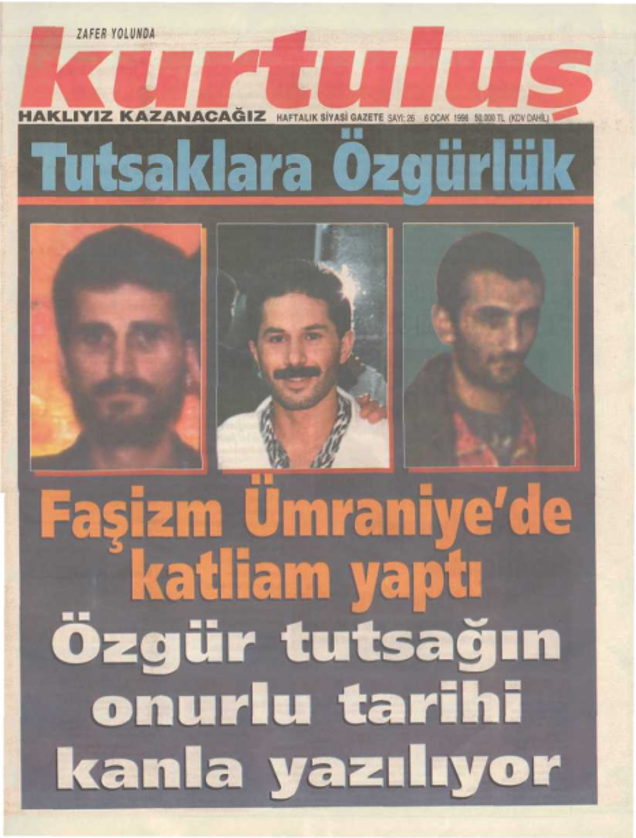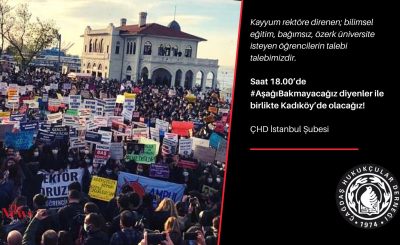To the press and the public:
MASSACRE IN ÜMRANIYE
3 prisoners from the DHKP-C murdered, more than 36 wounded. 29 guards and prison directors held hostage by prisoners. Protests in Turkey and abroad continue. The repression of the last months by the Turkish state against the prisoners continuies. In an attack by the state forces against the revolutionary prisoners in Ümraniye (Istanbul) on January 4, 1996, 3 prisoners from the DHKP-C (Riza Baybas, Abdülmecit and Orhan Özen) were killed and more than 36 prisoners were wounded. The attack was especially targeted against the block of the DHKP-C (Revolutionary People’s Liberation Party-Front) prisoners. There already had been an attack by the state forces against the prisoners in the Buca-prison in Izmir. In this attack, on September 21, 1996, there were also 3 prisoners from the DHKP-C killed and 63 prisoners were seriously wounded. In protest against this massacre, thousands of revolutionary prisoners in the whole of Turkey went on hungerstrike for a indefinite time. The prisoners on hungerstrike demanded:
– respect for the human rights in the prisons,
– prosecution of those who are responsible for the massacre in Buca,
– the closure of the special type prison in Ümraniye.
The Ümraniye-prison is a European type prison. It is known and notorious in Turkey as a coffin-prison. Contrary to other Turkish prisons the prisoners are kept in solitary confinement. Over and over again the prison board tries to take away the prisoners’ rights. Arbitrary bans on visits by lawyers and relatives, attacks on prisoners during their way to court, bans on legal papers and books, denying medical treatment… that is the order of the day. The last attack against the Ümraniye-prison occurred on December 13, 1995. While they were careful enough not to kill any prisoners during this attack, because of the coming elections, the violence they used in the attack after the elections was exceedingly brutal.
The stories to the “Demokrasi” paper from the physicians and the nurses of the Numune-hospital, where the wounded prisoners were brought to, published on January 6, are witness to this: “The attacks were meant to kill. The prisoners had serious wounds all over their bodies, caused by blows with heavy objects.” One nurse tells, with tears in her eyes: “Many prisoners had their head and liver crushed. I was afraid to touch them. When I carried the prisoners I was afraid to touch their head. I feared my fingers would penetrate their brain. These people hadn’t even had the opportunity to move their head, and yet they were beaten so brutally. While we tried to nurse the wounded, the soldiers constantly tried to prevent this. They yelled: “Let them starve, we have given them enough already.” They cursed the prisoners. To curse at people who are so badly wounded, one must have lost all human feelings.” Another nurse told “Demokrasi”: “It is a lie that there were also wounded soldiers were brought to the hospital. We don’t have any soldiers here. The prison board is probably spreading these stories to justify the attack on the prison.”
It is obvious that this massacre has been prepared for a long time. For months the Turkish press has waged a smear campaign against the political prisoners. During the attack of December 13, 1995, pictures of Caferi Sadik Eroglu, the prisoners’ representative, were spread among the state forces.
With that they gave the order to kill him. The order to attack the prison came from the chief of the Anti-Terror Department in Istanbul, Resat Altay. Zeki Güngör, responsible for all prisons in Turkey, told the press that this attack happened because the prisoners had refused to co-operate in the
countings. However, in their conversation with “Demokrasi” the prisoners stated that these countings were executed normally. Güngör also said that the Justice Department knew about the coming attack and that they would give a statement to the press. After the attack on the Ümraniye-prison, in which three people were killed, there were protests in several parts of Istanbul and in three prisons in Turkey. The prisoners in Ankara, Istanbul-Bayrampasa and Istanbul-Ümraniye
took several guards and one, respectively two, directors hostage. In front of the prisons, the hospital in Numunu, the prison hospital in Bayrampasa, as well as in Sultanahmet where the relatives of the disappeared and the prisoners gather every week to remind people of the disappeared, relatives of the prisoners and other people gathered to protest the massacre. There they waited the whole day for news about the situation of the prisoners and on January 6 they gathered in front of the Justice Department building to lodge a complaint against those who are responsible for the massacre. Next,
the police attacked the people who protested the massacre in a brutal manner. Elderly women and women with children on their arm were thrown against the ground. The press wasn’t spared either in this attack by the police.
At the same time there were several actions abroad by the DHKP-C and solidary organisations, protesting the massacre. A few examples:
– On January 4, 1996, the office of the THY (Turkish airline company), owned by the Turkish state, was destroyed in Hamburg (Germany).
– On January 4, 1996, banners were put up against the building of the Ziraat Bankasi in Duisburg (Germany). It read: “The fallen in Ümraniye are immortal”. On January 5, the DHKP-C and the MLKP organised a rally in which 100 people took part. The police, who didn’t want to tolerate this action, attacked the People’s Culture House in Duisburg.
– In Berlin (Germany), the DHKP-C, MLKP and MLSPB organised a demonstration on January 5 to draw attention to the massacre.
– On January 5 the consulate of the Turkish Republic in Mainz (Germany) was occupied by 15 people from the DHKC.
– In Bremen (Germany), the studio from Radio Bremen was occupied on January 5 by sympathisers of the TIKB and the DHKC. They published a statement to show solidarity with the prisoners in Ümraniye.
– In Cologne (Germany), a building from the THY (Turkish airline company) and two banks were attacked with molotov-cocktails.
– In France, the office from the THY was attacked with bricks and sticks.
– In Greece, the office from the THY was pelted with red paint, symbolising blood. Some banners were put up also, and pamphlets were spread.
– In Vienna (Austria) and London (England) statements were spread by the DHKC-Information offices, protesting the massacre in Ümraniye.
We call upon the public to protest the fascist actions of the Turkish government and to show solidarity with the prisoners in the Ümraniye-prison. Each letter of protest, each action can prevent a further massacre in the prisons.
Translation: Ozgurluk press agency; January 1996




